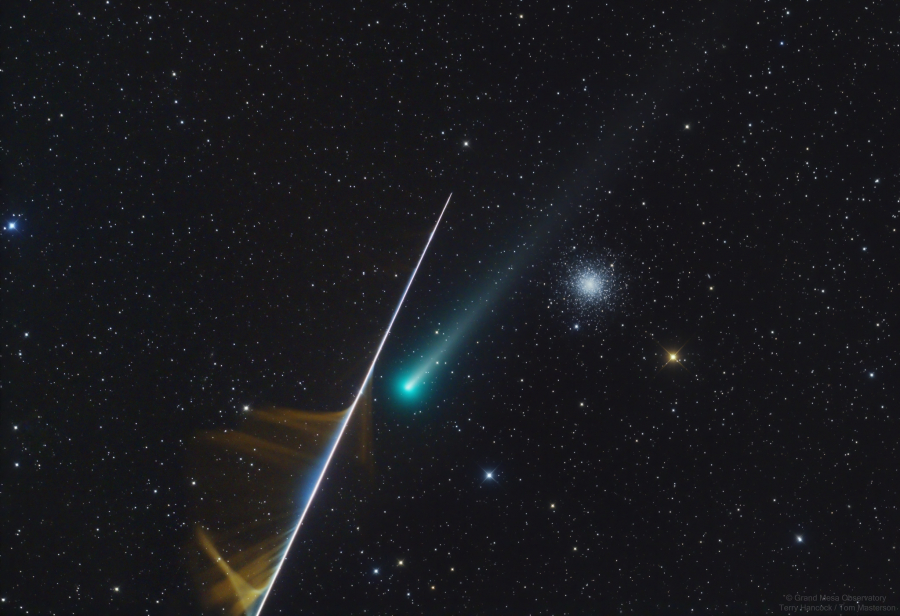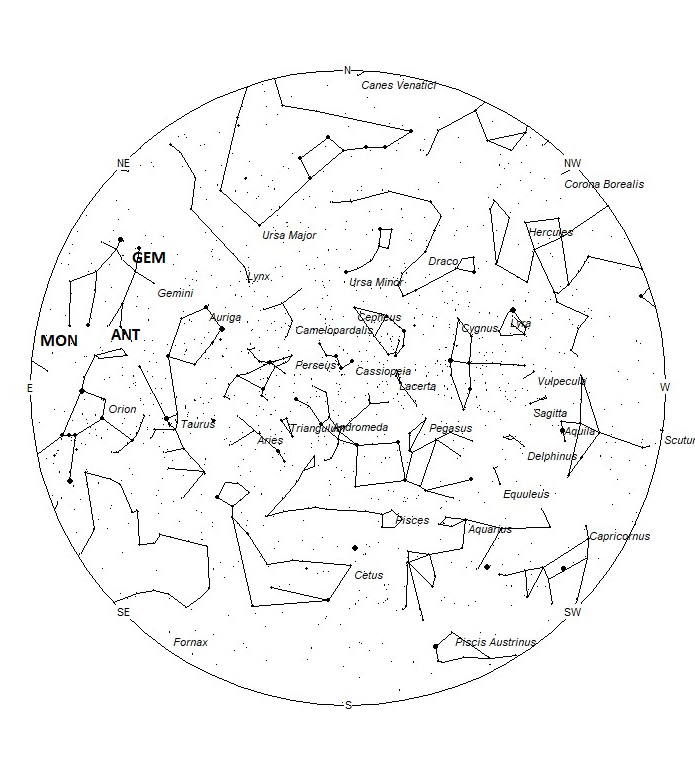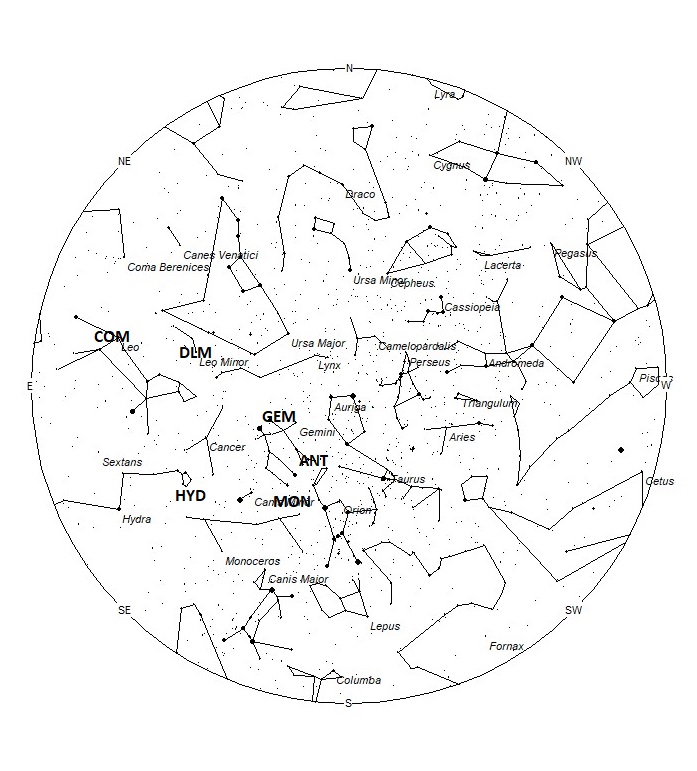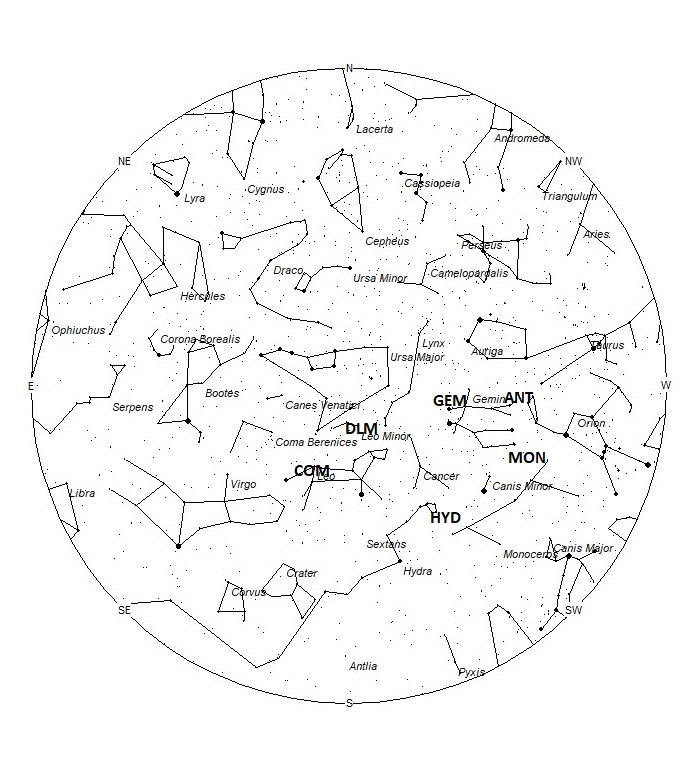 Terry Hancock and Tom Masterson were photographing comet C/2021 A1 Leonard’s passage by the globular cluster Messier 3 on the morning of 3 December 2021 from Grand Mesa Observatory, Purdy Mesa, Colorado, USA. During this exposure a bright meteor passed through the field of view leaving a bright streak and ghostly golden strands from the resulting train. Technical information: 4:31 AM MST (11:31 UT), December 3rd, 2021 Single 120 second combined with 40% mix for noise reduction from a 90 x 120 second stack. Camera: QHY367 Pro C Full Frame One Shot Color CMOS Optics: Takahashi E-180 Astrograph Image Acquisition software Maxim DL6 Pre-Processed in Pixinsight Post Processed in Photoshop. ©Terry Hancock and Tom Masterson https://www.transientastronomer.com
Terry Hancock and Tom Masterson were photographing comet C/2021 A1 Leonard’s passage by the globular cluster Messier 3 on the morning of 3 December 2021 from Grand Mesa Observatory, Purdy Mesa, Colorado, USA. During this exposure a bright meteor passed through the field of view leaving a bright streak and ghostly golden strands from the resulting train. Technical information: 4:31 AM MST (11:31 UT), December 3rd, 2021 Single 120 second combined with 40% mix for noise reduction from a 90 x 120 second stack. Camera: QHY367 Pro C Full Frame One Shot Color CMOS Optics: Takahashi E-180 Astrograph Image Acquisition software Maxim DL6 Pre-Processed in Pixinsight Post Processed in Photoshop. ©Terry Hancock and Tom Masterson https://www.transientastronomer.comDuring this period, the moon reaches its first quarter phase on Saturday December 11. At that time the moon lies 90 degrees east of the sun and sets near midnight local standard time. As the week progresses the waxing gibbous moon will set approximately 45 minutes later each night and by the end of the week it will be above the horizon all night long. The estimated total hourly meteor rates for evening observers this week is near 3 as seen from mid-northern latitudes (45N) and 2 as seen from tropical southern locations (25S). For morning observers, the estimated total hourly rates should be near 40 as seen from mid-northern latitudes (45N) and 20 as seen from tropical southern locations (25S). The actual rates will also depend on factors such as personal light and motion perception, local weather conditions, alertness, and experience in watching meteor activity. Evening rates are reduced during this period due to interfering moonlight. Note that the hourly rates listed below are estimates as viewed from dark sky sites away from urban light sources. Observers viewing from urban areas will see less activity as only the brighter meteors will be visible from such locations.
The radiant (the area of the sky where meteors appear to shoot from) positions and rates listed below are exact for Saturday night/Sunday morning December 11/12. These positions do not change greatly day to day so the listed coordinates may be used during this entire period. Most star atlases (available at science stores and planetariums) will provide maps with grid lines of the celestial coordinates so that you may find out exactly where these positions are located in the sky. I have also included charts of the sky that display the radiant positions for evening, midnight, and morning. The center of each chart is the sky directly overhead at the appropriate hour. These charts are oriented for facing south but can be used for any direction by rotating the charts to the desired direction. A planisphere or computer planetarium program is also useful in showing the sky at any time of night on any date of the year. Activity from each radiant is best seen when it is positioned highest in the sky, either due north or south along the meridian, depending on your latitude. It must be remembered that meteor activity is rarely seen at the radiant position. Rather they shoot outwards from the radiant, so it is best to center your field of view so that the radiant lies at the edge and not the center. Viewing there will allow you to easily trace the path of each meteor back to the radiant (if it is a shower member) or in another direction if it is sporadic. Meteor activity is not seen from radiants that are located far below the horizon. The positions below are listed in a west to east manner in order of right ascension (celestial longitude). The positions listed first are located further west therefore are accessible earlier in the night while those listed further down the list rise later in the night.
These sources of meteoric activity are expected to be active this week.
.
Now that the activity from particles produced by comet 2P/Encke have ceased encountering the Earth, the Taurid showers for 2021 are over and we resume reporting activity from the Anthelion (ANT) radiant. This is not a true radiant but rather activity caused by the Earth’s motion through space. As the Earth revolves around the sun it encounters particles orbiting in a pro-grade motion that are approaching their perihelion point. They all appear to be radiating from an area near the opposition point of the sun, hence the name Anthelion. These were once recorded as separate showers throughout the year, but it is now suggested to bin them into a category separate from true showers and sporadics. This radiant is a very large oval some thirty degrees wide by fifteen degrees high. Activity from this radiant can appear from more than one constellation. The position listed here is for the center of the radiant which is currently located at 06:08 (92) +23. This position lies in western Gemini, near the spot occupied by the 4th magnitude star known as 1 Geminorum. Since the radiant is so large, Anthelion activity may also appear from southeastern Auriga, Gemini, and northeastern Orion as well as eastern Taurus. This radiant is best placed near midnight local standard time (LST) when it lies on the meridian and is highest in the sky. Rates at this time should be near 2 per hour as seen from the northern hemisphere and 1 per hour as seen from south of the equator. With an entry velocity of 30 km/sec., the average Anthelion meteor would be of medium-slow velocity.
The Monocerotids (MON) are active from November 23 through December 24 with the peak activity occurring on December 11th. The radiant is currently located at 06:47 (102) +08. This position lies in northern Monoceros, near the spot occupied by the faint star known as 17 Monocerotis. This position is only 6 degrees south of the radiant of the November Orionids so care must be taken to distinguish between the two. Current rates should be near 2 per hour as seen from the Northern Hemisphere and near 1 as seen from south of the equator. The Monocerotids are best seen near 0100 LST when the radiant lies highest above the horizon. At 41 km/sec. the Monocerotids produce mostly meteors of medium velocity.
The Geminids (GEM) reach maximum activity on the night of December 13/14 with the radiant located at 07:28 (112) +33. This position lies in northern Gemini, 2 degrees northwest of the 2nd magnitude star known as Castor (alpha Geminorum). Rates this weekend should be near 20 per hour as seen after moonset from the Northern Hemisphere and near 5 as seen from south of the equator. This radiant is best placed in the sky near 0200 LST, when it lies highest above the horizon. At 34 km/sec. the Geminids produce mostly meteors of medium velocity.
The Puppid-Velids (PUP) are a vast complex of weak radiants located in the constellations of Puppis and Vela. Visual plots and photographic studies have revealed many radiants in this area during November and December. The combined strength of these radiants can produce a ZHR of 10. Actual hourly rates will be much less unless you happen to be observing from the deep Southern Hemisphere. Activity from this source begins around December 1st. The center of this activity is currently located at 08:24 (126) -45. This position lies in western Vela, 2 degrees southwest of the 4th magnitude star known as e Velorum. Peak rates occurred near December 7. These meteors are best seen near 0300 LST when the radiant lies highest above the horizon in a dark sky. Observers located in the Southern Hemisphere have an advantage viewing this shower as the radiant will rise higher into their sky allowing more activity to be seen. Since the radiant lies low in the south for most northern hemisphere observers, meteors seen from north of the equator tend to be long in length and long-lasting. At 40 km/sec. the Puppid-Velids produce meteors of average velocity. Note: these are also listed as the “e Velids” from several sources.
The sigma Hydrids (HYD) are active from a radiant located at 08:28 (127) +02. This area of the sky is located in western Hydra, 2 degrees southwest of the 4th magnitude star known as sigma Hydrae. Current rates should be near 2 per hour no matter your location. These meteors are best seen near 0300 LST, when it lies highest above the horizon in a dark sky. With an entry velocity of 58 km/sec., the average sigma Hydrid meteor would be of swift velocity.
The December Leonis Minorids (DLM) are a shower of long duration active from December 1st all the way through February 10th. Maximum occurs near December 19th when rates may reach 3 an hour. During this period, I would expect hourly rates of 2 from a radiant located at 10:16 (154) +35. This position lies in central Leo Minor, 1 degree southeast of the faint star known as 21 Leonis Minoris. These meteors are best seen near 0400 LST when the radiant lies highest above the horizon. At 64 km/sec. the December Leonis Minorids produce mostly swift meteors. These meteors are known most commonly as the Comae Berenicids.
The Comae Berenicids (COM) are active from December 12-23, with maximum activity occurring on the 16th. The radiant for this source currently lies at 11:19 (172) +20. This area of the sky lies in eastern Leo, 1 degree southeast of the 3rd magnitude star known as Zosma (delta Leonis). This area of the sky is best placed near 06:00 LST, when the radiant lies highest in the sky. Current rates would be near 1 per hour as seen from the northern hemisphere and less than 1 as seen from south of the equator. At 65 km/sec. the Comae Berenicids produce mostly swift meteors.
As seen from the mid-northern hemisphere (45N) one would expect to see approximately 11 sporadic meteors per hour during the last hour before dawn as seen from rural observing sites. Evening rates would be near 2 per hour. As seen from the tropical southern latitudes (25S), morning rates would be near 8 per hour as seen from rural observing sites and 1 per hour during the evening hours. Locations between these two extremes would see activity between the listed figures. Evening rates are reduced by interfering moonlight during this period.
| SHOWER | DATE OF MAXIMUM ACTIVITY | CELESTIAL POSITION | ENTRY VELOCITY | CULMINATION | HOURLY RATE | CLASS |
| RA (RA in Deg.) DEC | Km/Sec | Local Standard Time | North-South | |||
| Anthelion (ANT) | – | 06:08 (92) +23 | 30 | 00:00 | 3 – 2 | IV |
| Monocerotids (MON) | Dec 09 | 06:47 (102) +08 | 41 | 01:00 | 2 – 1 | II |
| Geminids (GEM) | Dec 14 | 07:28 (112) +33 | 35 | 02:00 | 20 – 5 | I |
| Puppid-Velids (PUP) | Dec 07 | 08:24 (126) -45 | 40 | 03:00 | <1 – 2 | II |
| sigma Hydrids (HYD) | Dec 09 | 08:28 (127) +02 | 58 | 03:00 | 2 – 2 | II |
| December Leonis Minorids (DLM) | Dec 19 | 10:16 (154) +35 | 64 | 05:00 | 2 – 1 | II |
| Comae Berenicids (COM) | Dec 16 | 11:19 (172) +20 | 65 | 06:00 | 1 – <1 | II |







 You saw something bright and fast? Like a huge shooting star? Report it: it may be a fireball.
You saw something bright and fast? Like a huge shooting star? Report it: it may be a fireball.  You counted meteors last night? Share your results with us!
You counted meteors last night? Share your results with us!  You took a photo of a meteor or fireball? You have a screenshot of your cam? Share it with us!
You took a photo of a meteor or fireball? You have a screenshot of your cam? Share it with us!  You caught a meteor or fireball on video? Share your video with us!
You caught a meteor or fireball on video? Share your video with us!